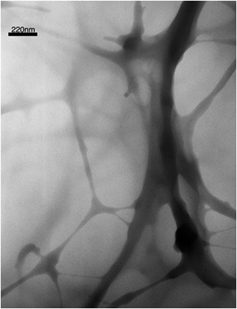Article contents
Solvent processed conductive polymer with single-walled carbon nanotube composites
Published online by Cambridge University Press: 30 October 2015
Abstract

Single-walled carbon nanotube (SWNT) and conductive polymer composite were studied as a potential electrode candidate for plastic electronic devices such as organic light-emitting diodes (OLEDs) and solar cells. A novel conductive polymer, poly(2,7–9,9(di(oxy-2,5,8-trioxadecane))fluorene) (PFO), was synthesized and characterized as a surfactant to disperse SWNTs in solutions. The ethylene oxide (EO) side chain of rigid PFO backbone acts as a template to wrap around SWNTs in solution. Up to 0.02% (by weight) of SWNTs are stabilized and well separated in the solution phase. The carbon nanotube can be dispersed in solutions for over 4 mo. Transmission electron microscopy (TEM) images of solvent cast film suggest highly uniformed SWNT distribution incorporated in the conductive polymer matrix. Transmittance characterization shows the film is as transparent as indium tin oxide conducting glass. Conductivity measurement shows SWNTs can effectively inject charges into the PFO polymer matrix at low voltage. The current versus voltage profile of the SWNT/PFO composite film (2% SWNT in PFO by weight) shows that the majority current conducting is carried by SWNTs.
- Type
- Articles
- Information
- Copyright
- Copyright © Materials Research Society 2015
References
REFERENCES
- 4
- Cited by


